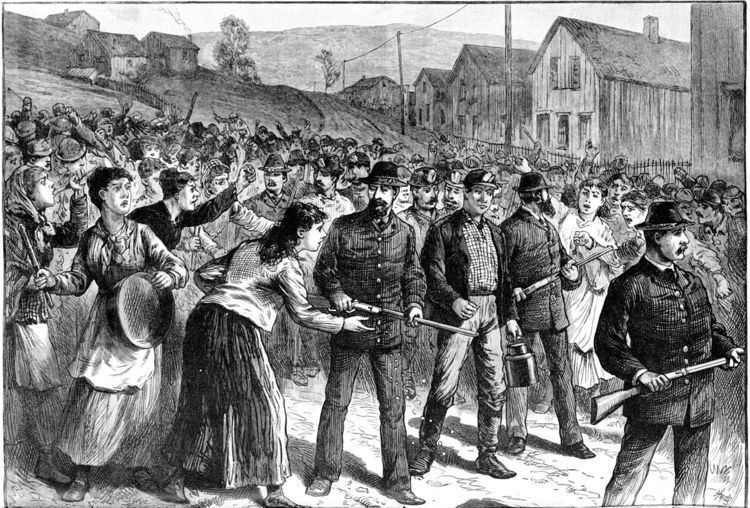 | ||
A strikebreaker (sometimes derogatorily called a scab, blackleg, or knobstick) is a person who works despite an ongoing strike. Strikebreakers are usually individuals who are not employed by the company prior to the trade union dispute, but rather hired after or during the strike to keep the organization running. "Strikebreakers" may also refer to workers (union members or not) who cross picket lines to work.
Contents
Strikebreakers are employed worldwide, often occurring wherever workers go on strike or engage in related actions. However, strikebreakers are used far more frequently in the United States than in any other industrialized country. The Mohawk Valley formula calls for the use of strikebreakers when dealing with striking employees.
International law
The right to strike is not expressly mentioned in any convention of the International Labour Organization (ILO); however, the ILO's Freedom of Association Committee established principles on the right to strike through ongoing rulings. Among human rights treaties, only the International Covenant on Economic, Social and Cultural Rights contains a clause protecting the right to strike. However, like the Social Charter of 1961, the Covenant permits each signatory country to abridge the right to strike.
The ILO Committee on Freedom of Association and other ILO bodies have, however, interpreted all core ILO conventions as protecting the right to strike as an essential element of the freedom of association. For example, the ILO has ruled that "the right to strike is an intrinsic corollary of the right of association protected by Convention No. 87."
The ILO has also concluded striker replacement, while not in contravention of ILO agreements, carries with it significant risks for abuse and places trade union freedoms "in grave jeopardy."
The European Social Charter of 1961 was the first international agreement to expressly protect the right to strike. However, the European Union's Community Charter of the Fundamental Social Rights of Workers permits EU member states to regulate the right to strike.
Asia
Europe
In most European countries, strikebreakers are rarely used. Consequently, they are rarely if ever mentioned in most European national labor laws. As mentioned above, it is left to the European Union member states to determine their own policies.
North America
Synonyms
Strikebreaking is also known as "black-legging" or "blacklegging". American lexicographer Stephanie Smith suggests that the word has to do with bootblacking or shoe polish, for an early occurrence of the word was in conjunction with an 1803 American bootmaker's strike. But British industrial relations expert J.G. Riddall notes that it may have a racist connotation, as it was used in this way in 1859 in the United Kingdom: "If you dare work we shall consider you as blacks..." Lexicographer Geoffrey Hughes, however, notes that "blackleg" and "scab" are both references to disease, as in the blackleg infectious bacterial disease of sheep and cattle caused by Clostridium chauvoei. He dates the first use of the term "blackleg" in reference to strikebreaking to the United Kingdom in 1859. Hughes observes that the term was once generally used to indicate a scoundrel, a villain, or a disreputable person. However, the Northumbrian folk song Blackleg Miner is believed to originate from the 1844 strike, which would predate Hughes's reference. David John Douglass claims that the term blackleg has its origins in coal mining, as strikebreakers would often neglect to wash their legs, which would give away that they had been working whilst others had been on strike.
Hughes notes that the use of the term "scab" can be traced back to the Elizabethan era in England, and is much more clearly rooted in the concept of disease (e.g., a diseased person) and a sickened appearance. The word is occasionally still used as a general insult in Britain; for example, during a mock funeral for Margaret Thatcher in 2013 in Goldthorpe, the word "scab" was spelled out in flowers as part of the display. A traditional English proverb, which advises against gossip, is He that is a blab is a scab.
John McIlroy has suggested that there is a distinction between a blackleg and a scab. He defines a scab as an outsider who is recruited to replace a striking worker, whereas a blackleg is one already employed who goes against a democratic decision of their colleagues to strike, and instead continues to work. The fact that McIlroy specified that this should be a "democratic" decision has led the historian David Amos to question whether the Nottinghamshire miners in 1984-5 were true blacklegs, given the lack of a democratic vote on the strike.
